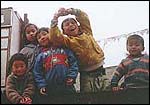


|
|
 |
| HOME | TRAVEL | TRAVELOG | ||

Last Train to Darjeeling ... a hill station of the Raj Jaideep and Suniti Mukerji
It is obvious that lightning quick reflexes is the key to survival here. The drivers who are a fraction slow in getting out of harm's way have long been eliminated -- either mangled into scrap metal by the train or else pushed over the edge of the road.
The Lower Bazaar is where the locals shop -- a maze of crowded narrow lanes lined with cubbyhole shops. There are steep alleys lined with shops that only sell steel and copper utensils and winding lanes lined with shops full of large sacks of bright coloured spices and lentils. Fruit and vegetable stalls -- selling the best Assamese pineapples, Sikkimese oranges and crisp fresh vegetables from nearby kitchen gardens -- occupy another section of the market. Most tourists do not venture this far. They limit themselves to the 'Mall', a common feature of all Indian hill resorts, where the photography and woollen clothing stores are located. The road leading to the Chowrasta -- the town centre of Darjeeling that straddles the ridge -- is lined with pavement stalls owned by very persuasive Tibetan ladies selling the very latest in brand name clothing, footwear and electronics. Most things say 'Made in Japan', but are likely to have come from a few miles down the road. The Oxford Book Shop in Chowrasta, however, is one of the best bookstores that I have come across with shelves packed with rare out of print books on the early Himalayan explorations of the area.
The sky is turning pale by the time we cover the 14 kms and start steeply climbing the last few bends to the windy 'view point' where I join a few hundred keen tourists shuffling in the bitter cold all waiting for the sun to light up Kanchenjunga. It is a grand and spectacular view every bit worth the discomfort of the cold and the effort of the early rise. Someone points out the distant black pyramid of Everest and there is a chorus of excited and admiring "Oohs". I hire a jeep to Sandakphu -- a three hour drive away and 12,100 feet up on a ridge -- from where, I am told, there are even better views of Everest, Lhotse, Makalu and Kanchenjunga. The Singalila Ridge runs straight south from Kanchenjunga and forms the natural border between India and Nepal. The drive is memorable. The rhododendrons are in bloom in May and entire slopes are coloured deep pink and red, broken by the cream and white of the magnolia flowers. The 'road' -- actually a stone cobbled pony trail now in a state of serious disrepair -- is so steep in sections that our driver needs all the available low gears of his ageing four wheel drive jeep to coax it up the last few bends. I share a large 'trekkers hut' built by the local tourism department with a group of university students from Calcutta trekking in the area. They are keen, but not well equipped for the cold and the altitude. They ask the hut caretaker to light up the wood stove but I object to the unnecessary burning of wood , when I see the man bringing in a pile of firewood likely cut from the nearby slopes. The trekkers are cold and not pleased with me and we have a bit of an argument about the impact of deforestation. The following morning I see another visiting family, parents and children clearly educated in expensive city schools, carelessly tossing their biscuit wrappers and potato chip bags beside the trail. Somehow, the message that we need to protect and cherish these few remaining pockets of wilderness in India is not getting across. The first rays of the rising sun strike Kanchenjunga soon after five the next morning. The mountain appears painted in brilliant gold. On a clear day, the views of Kanchenjunga from the ridge above the Sandakphu hut are both impressive and remarkable. The 28,400 feet high mountain lies only 40 kms away and its enormous white bulk fills the western horizon. It is definitely worth the cold night spent in the hut with grumbling room mates.
It has been an enjoyable tour. Friendly people, tropical valleys, cultivated green hills and towering snow peaks sums up a little of what I have seen. Mirik and Gangtok and the sights of Sikkim await another visit to this fascinating part of India. Photographs by Jaideep Mukerji and Kevin J Vogeley
|
|
|
Back
|
|
|
|
|
|
HOME |
NEWS |
BUSINESS |
CRICKET |
MOVIES |
CHAT
INFOTECH | TRAVEL | LIFE/STYLE | FREEDOM | FEEDBACK |
|